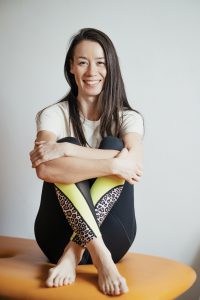-
Maria Koncewicz – fizjoterapeutka
Jestem magistrem fizjoterapii, dyplomowaną terapeutką manualną, absolwentką Uniwersytetu Medycznego w Poznaniu. Posiadam prawo wykonywania zawodu fizjoterapeuty do zweryfikowania w Krajowym Rejestrze Fizjoterapeutów.
Specjalizuję się w leczeniu dysfunkcji układu ruchu za pomocą terapii manualnej według szkoły niemieckiej oraz w prowadzeniu treningu medycznego umożliwiającego powrót do aktywności fizycznej po kontuzji. Doświadczenie zawodowe zdobywałam współpracując jako fizjoterapeuta z zawodnikami Wyścigowych Motocyklowych Mistrzostw Polski. W tej grupie sportowców prowadziłam również pionierskie badania dotyczące poziomu ich wydolności fizycznej.
Od 2013 roku mam przyjemność współpracować z muzykami podczas ich tras koncertowych w Polsce. Mojemu doświadczeniu zaufali już wykonawcy z Roger Waters the Wall tour oraz zespół Nickelback.
W wolnych chwilach biegam na średnich dystansach, pływam, jeżdżę na rowerze. Interesuję się zdrowym żywieniem i racjonalnym podejściem do diety.
Najważniejsze szkolenia:
Terapia manualna szkoła niemiecka – ustrukturyzowany system pracy terapeutycznej polegający na określeniu lokalizacji zaburzonej struktury (mięsień, staw, nerw), wprowadzeniu terapii poprawiającej ruchomość danej struktury oraz ćwiczenie/ruch wzmacniający układ mięśni odpowiadających za pracę osłabionej struktury.
FMS functional movement system – koncepcja identyfikująca problem związany z ruchem (asymetria w ciele, brak siły, brak mobilności) i wprowadzająca ćwiczenia redukujące te deficyty. Początek rozumienia wpływu wzorców postawy na ból i kontuzje.
Trening Pilates – rozumienie ruchu ciała jako całości, gdzie istotą jest kontrola ustawienia centrum – brzucha i klatki piersiowej na których opiera się ruch kończyn. Istota prawidłowego oddechu skoordynowanego z każdym ruchem. Świadomość położenia ciała w przestrzeni i odciążanie stawów poprzez ciagłą pracę antygrawitacyjną mięśni szkieletowych.
Zoga Movement – spojrzenie na ciało jako całość w ruchu w 3 wymiarach z uwzględnieniem położenia narządów wewnętrznych, wiązek naczyń i nerwów. Pojęcie tensegracji w ciele (tension – napięcie, integrity – integracja) czyli wzajemnej stabilizacji elementów rozciąganych i ściskanych. Ciało jako układ przestrzenny, w którym elementy sztywne (kości) są połączone i utrzymywane w pozycji poprzez elementy elastyczne (tkanki miękkie). Położenie elementów kostnych jest definiowane poprzez naprężenie tkanek miękkich, innymi słowy możemy wpływać na stawy przez pracę nad elastycznością tkanek miękkich. Zoga Movement jest jedną z koncepcji integracji strukturalnej, gdzie poprzez pracę nad napięciem tkanek miękkich wpływamy na ustawienie ciała w przestrzeni.
Bone Work Sharon Wheeler – unikalna koncepcja pracy z kośćmi przywracająca im prawidłową pozycję w relacji do tkanek miękkich oraz innych kości. Jest to metoda pracy również na tkance kostnej samej w sobie, przywracająca naturalny kształt kości zdeformowanej poprzez uraz.
english below…
I am a master of physiotherapy, a certified manual therapist, and a graduate of the Medical University of Poznan. I have the right to practice as a physiotherapist verified in the National Register of Physiotherapists.
I specialize in treating dysfunctions of the musculoskeletal system using manual therapy according to the German school and in conducting medical training to enable a return to physical activity after injury. I gained professional experience working as a physiotherapist with athletes in the Polish Motorcycle Racing Championship. In this group of athletes, I also conducted pioneering research on their physical fitness level.
Since 2013, I have had the pleasure of working with musicians during their concert tours in Poland. Performers from the Roger Waters the Wall tour and the Nickelback band have already trusted my experience.
In my free time, I run medium distances, swim, and cycle. I am interested in healthy eating and a rational approach to diet.
Key trainings:
German school of manual therapy – a structured therapeutic work system consisting of identifying the location of the disrupted structure (muscle, joint, nerve), introducing therapy that improves the mobility of the structure, and exercise/movement that strengthens the muscle system responsible for the weakened structure’s function.
FMS functional movement system – a concept identifying movement-related problems (asymmetry in the body, lack of strength, lack of mobility) and introducing exercises that reduce these deficits. The beginning of understanding the impact of posture patterns on pain and injuries.
Pilates training – understanding body movement as a whole, where the essence is the control of the center’s position – the abdomen and chest, on which the movement of the limbs is based. The essence of proper breathing coordinated with each movement. Awareness of body position in space and unloading joints through continuous anti-gravity work of skeletal muscles.
Zoga Movement – a view of the body as a whole in motion in three dimensions, taking into account the position of internal organs, bundles of vessels, and nerves. The concept of tensegrity in the body (tension and integrity), which is the mutual stabilization of stretched and compressed elements. The body as a spatial system, in which rigid elements (bones) are connected and maintained in position by elastic elements (soft tissues). The position of the bone elements is defined by the tension of the soft tissues. In other words, we can influence joints by working on the elasticity of soft tissues. Zoga Movement is one of the concepts of structural integration, where by working on soft tissue tension, we influence the body’s position in space.
Bone Work and Cranial Work Sharon Wheeler – a unique concept of working with bones, restoring their proper position in relation to soft tissues and other bones. This is also a method of working on bone tissue itself, restoring the natural shape of a bone deformed by injury.
kontakt
Fizjoterapia i Terapia Manualna
Maria Koncewicz
ul. Marszałkowska 140 lokal 139B
Warszawa-Centrum
telefon 606 354 066
e-mail maria@gabinet.waw.pl
Najpopularniejsze
rehabilitacja kręgosłupa
rehabilitacja kolana
rehabilitacja biodra
terapia manualna Warszawa
masaż sportowy Warszawa
masaż pleców Warszawa
kinesiotaping Warszawa
bark zamrożony
dyskopatia
masaż powięziowy
drenaż limfatyczny Warszawa
masaż Warszawa
Pilates reformer
Pilates wunda chair
Ankieta
Copyright © 2011-2023 Fizjoterapia Maria Koncewicz
